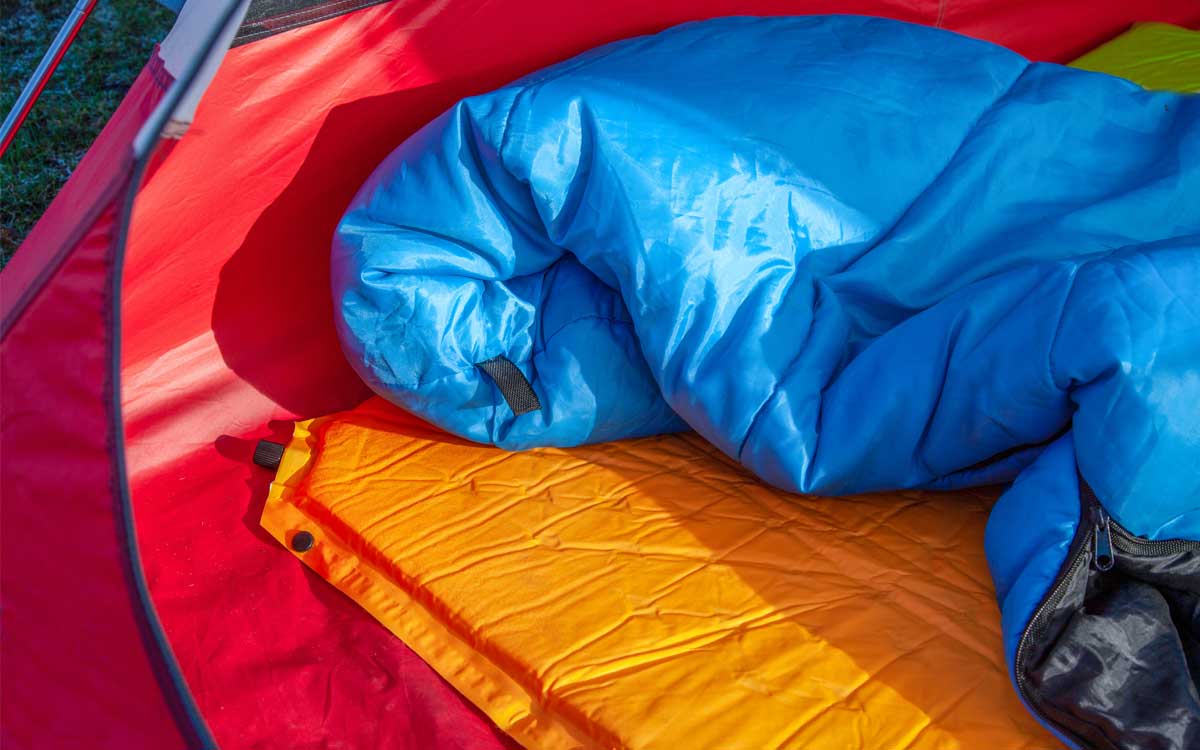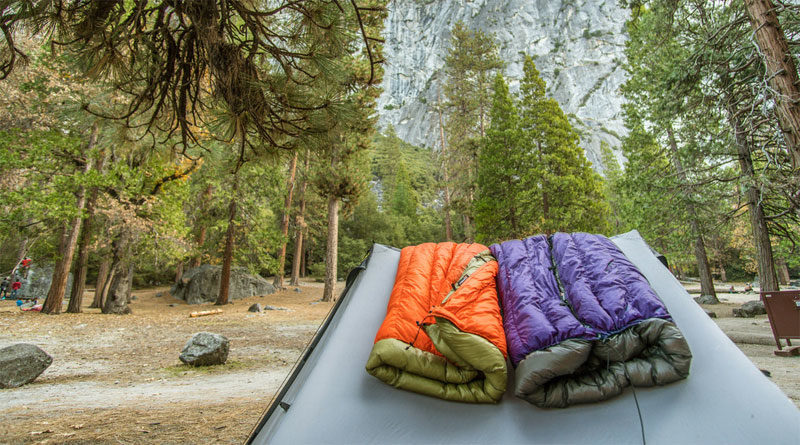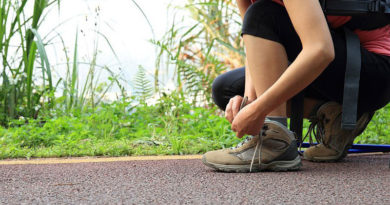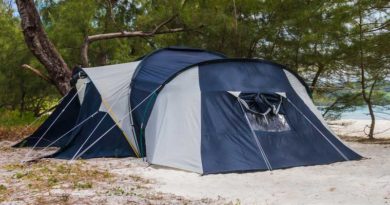Best Budget Ultralight Sleeping Bags of 2024
Sleeping bags are one of the heaviest items if you are backpacking or thru-hiking. For ultralight backpacking, every ounce matters and a heavy sleeping bag can ruin your whole weight management. With technological innovation, new materials, and manufacturing methods, sleeping bags have become much lighter. There is even an ultralight category these days but these bags come with a hefty price tag. However, if you are a budget-conscious backpacker and looking for an ultralight bag, here is the list of top models that you can get without breaking the bank.
1. Marmot Micron

Weight: 1 lb. 6 oz.
Fill: 650-fill down
Rated to: 40°F
Shell: Ripstop nylon
The Marmot Micron 40 is a cheap sleeping bag that is both ultralight and durable. This bag has features like a hydrophobic down, a full-length zipper, an internal pocket, and a nice foot box. Usually, features like these cost a premium but Marmot has raised the bar of a budget offering with the Micron 40. This bag is packed with features that make the bag a great value option. This bag has a 650-fill down and a 20-denier shell which isn’t premium but warmer and more durable than many others. It also gives you an entry-level option to start in the ultralight category. But you have to understand what you are paying for. For the price, this is a great value bag.
At a low cost, this bag comes with a down fill. The fill is treated with a hydrophobic coating to keep it from being wet. The bag has a full-length zipper that extends through the foot box as well. This feature is handy and it allows for full ventilation on warm nights and can be used as a blanket. You also get an internal pocket that is large enough to hold a phone. The Micron 40 weighs around 1.5 pounds which is competitive with some premium bags that cost a lot more.
What I like: Premium materials and features at an affordable price.
What I don’t like: A little heavy for its temperature rating.
2. REI Co-op Magma
Weight: 1 lb. 3.8 oz.
Fill: 850-fill down
Rated to: 30°F
Shell: Pertex®
The REI Co-op line has increased its quality and value over time. It is an attractive line for those who are looking for excellent budget options. The REI Co-op Magma 30 is a quality ultralight backpacker bag for a reasonable price. The Magma 30 has some impressive specs. It has 850-fill power down and weighs only 1 pound and 4 ounces for the long version. It provides decent warmth and is also comfortable and versatile. The insulation does a good job of retaining body heat along with a draft collar. For an ultralight bag, the Magma is warm enough for 3-season use.
Even the stuff sack that comes with the Magma 30 is ultralight at only 0.4 ounces. The bag has a 63-inch wide shoulder girth. The minimum pack size of the Magma 30 is 6.7 liters. But you would need a third-party compression bag to achieve that. It would cost you up to a hundred dollars more to buy a sleeping bag with a similar performance. The Magma isn’t as good as the premium options on the market but it is close with a significant price difference. Once you start comparing, you will start seeing the value of the Magma 30. Its availability at REI also means that it is going to be on sale frequently.
What I like: Small pack size, cozy fabrics, and quality down
What I don’t like: Lacks some features, moderate warmth, less versatile
View at REI View Magma Quilt at REI
3. Therm-a-Rest Ohm

Weight: 1 lb. 6 oz.
Fill: 900-fill down
Rated to: 20°F
Shell: Ripstop nylon
Therm-a-Rest Ohm is a unique sleeping bag that can be converted to use as a 1-person bag or double-wide quilt. This versatility makes it a good option for 2- to 3-season backpacking. The hoodless bag is certainly built with a focus on weight savings and that starts with its premium 900-fill NIKWAX hydrophobic down insulation. This makes the regular version bag weigh just 2 ounces over a pound and even the long length is just 1 pound and 5 ounces. Also, unlike traditional down, this insulation has a high degree of water resistance. It is going to keep you insulated even if it gets damp. The ultralight 10D nylon ripstop shell also helps keep the weight low.
The bag has a semi-rectangular shape that gives it a little extra wiggle room at the shoulders and the chest which you usually find more restrictive in mummy cuts. It does taper at the feet to provide better thermal efficiency at the spot that can be prone to heat loss. The bag’s box baffle construction ensures that the down insulation is evenly distributed so you enjoy consistent warmth and don’t end up with inefficient cold spots. While there isn’t a hood, there’s a drawcord at the top of the bag so you can pull it close above your shoulders. Another interesting feature is the bag’s ability to completely unzip it for use as a backpacking quilt. Unzipped and unfolded is big enough to serve as a double-wide top quilt and it can even be zipped together with a second bag to create a fully enclosed double-wide bag.
What I like: Extremely versatile, can be completely unzipped to use as quilt, quality materials
What I don’t like: A little expensive, and the wraparound zipper is not for everyone
4. Sea to Summit Spark
Weight: 12.8 oz.
Fill: 850 goose Down
Rated to: 45°F
Shell: 10D nylon
For serious ultralight backpackers who are looking for the lightest option on the market, look no further. The Sea to Summit Spark 40 is the lightest and the smallest packing sleeping bag you can get your hands on. The Spark has a range from 5°F to 45°F. Spark 45 is for summer use. The outstanding point of the Spark 45 is its weight and packing size. It weighs only 12.8 ounces of which 6.3 ounces is the 850-fill down. The down is hydrophobic and packs smaller than 1 liter in the compression bag that comes with it. It’s a niche product that will only attract those who take lightweight backpacking as a challenge. For the specs, the price is also reasonable. Not cheap, but reasonable.
The sewn-through construction of this bag makes it extremely lightweight. It is an excellent backup for bivies. The Spark 45 can’t compare with other options in terms of warmth. But its weight and packing size are impressive for a 45-degree bag. It’s also a fully-featured bag with a hood and a zipper. Of course, the versatility is limited in such a lightweight design. Again, it’s not warm enough, to begin with. It has a 1/3 length zipper that limits space to move inside the bag and limits ventilation. But this bag is not for everyone.
What I like: A true ultralight bag with lots of features.
What I don’t like: Not the cheapest option and tight around the shoulders
See the Sea to Summit Spark See the Women’s Spark
5. Marmot Always Summer
Weight: 1 lb. 12.6 oz.
Fill: Down
Rated to: 40°F
Shell: Recycled ripstop nylon
Always Summer sleeping bag from Marmot is a great lightweight option for warm-weather adventures. This bag features water-resistant down insulation and a secondary zipper to cool you down on those warm summer nights. The recycled materials in the shell and lining let you sleep with a clear conscience. This bag uses RDS-certified 650 fill power water-resistant down insulation. Water-resistant down means that you get the lightweight warmth and compressibility of down with less worry about moisture. In fact, the treated down in this bag stays dry 10 times longer than untreated down in wet conditions. It dries faster when conditions improve.
With all that warm and down insulation you might want to vent some excess heat on warm nights. The secondary zipper located at the foot of the bag lets you get some air. Dual zippers make entry and exit simple. Flaps on these zippers form a wide blanket-like cover when you’re sitting up. When you’re ready to sleep, adjust the hood to dial in the fit. An internal stash pocket is a great place for small items. Offering worry-free down insulation and an extra venting zipper for warm nights, The Marmot Always Summer sleeping bag is a good option to consider.
What I like: The bag is very colorful and offers a great blend of lightweight and warmth.
What I don’t like: Not the roomiest bag and you feel restricted in certain positions
6. REI Co-op Helio Sack
Weight: 1 lb. 10 oz.
Fill: Synthetic
Rated to: 50°F
Shell: Recycled polyester
REI Co-op Helio Sack is a perfect sleeping bag for warm weather adventures that you can also use inside another sleeping bag on colder nights. REI has updated this bag with a better recycled polyester shell, lining, and insulation, which also makes it environmentally friendly. I have been using this bag for several years and it is still going strong. I have used it for various activities from summer backpacking to outdoor concerts. The bag is very versatile and functional, particularly the armholes and quilt mode. You can open the side of the bag and it unzips into a quilt. The short side zip can work as both a vent and an armhole.
The outer shell of the bag has a DWR finish, which resists moisture and stains. The included stuff sack compresses for packing, and the mesh expansion allows for breathable storage. The bag has a relaxed mummy shape that doesn’t cramp your sleeping style and the differentiated drawcords (1 round, 1 flat) make it easy to adjust the hood and neck in the dark. The included stuff sack compresses for packing, and the mesh expansion allows for breathable storage. What’s more, the REI Co-op Helio Sack 50 is made using bluesign®-approved materials, which conserve resources and protect the health of the environment, workers, and you!
What I like: The newer version has better materials, the long side unzips into a quilt
What I don’t like: A little tight around the legs, which sometimes makes it uncomfortable
7. Klymit KSB

Weight: 1 lb. 14.4 oz.
Fill: 650-fill down
Rated to: 35°F
Shell: Sil-nylon
The KSB 35 offered by Klymit is another bag that can be unzipped for use as a quilt. This bag is lightweight, packable, comes at a great price tag, and performs very close to how it is advertised. For a low price, you get great performance from this bag. Klymit has updated the KSB 35 recently. There are many improvements. The previous version had a complete 650-fill down while the new version has an 80/20 split in insulation. The whole upper area of the bag features a down fill while the lower toe box features synthetic fill to increase the warmth-to-weight ratio.
The updated version also features Length Lock technology and stretch baffles. The Length Lock is a set of small hooks on the outside of the bag that enable you to reduce the length of the bag. Although shorter hikers can get a shorter bag, this feature does add some versatility to the bag. The bag also comes with a compression bag instead of a simple stuff sack that allows you to pack it down to only 7 liters. It also features a full-length zipper and can be turned into a quilt. But with a low price, there are some expected compromises. The bag weighs around 2 pounds which can’t be termed as ultralight. But with a complete hood, draft collar, and a stash pocket, this is a great value bag.
What I like: Can be completely unzipped for use as a quilt.
What I don’t like: No draft collar or stash pocket, temperature rating is not accurate
8. Mountain Hardwear Bishop Pass
Weight: 1 lb. 12.4 oz.
Fill: 650-fill down
Rated to: 30°F
Shell: 20D ripstop nylon
The Mountain Hardwear Bishop Pass 30 is a packable sleeping bag with a simple and functional design. It is a decent performer in all domains and it provides all-around performance at a decent price tag. This bag features 15 ounces of 650FP duck down that provides decent warmth. The lower limit of this bag is 30°F making it an option for 3-season use. But this bag doesn’t include any extra features so the costs stay low. The main zipper is ¾ the length. It does provide enough space for ventilation and moving inside but a full-length zipper is always better. The bag also lacks a neck baffle which limits its heat-retaining capability.
The bag weighs around 1.98 pounds which is certainly not lightweight but it does present considerable weight savings compared to some other options on the market. For the pack size, it does pack down small. Not the smallest in the world but much more compact than many other options in this price range. However, you will need an extra compression sack to achieve the smallest possible size. Overall for an average backpacker, this bag provides excellent value along with some nice features.
What I like: A good weight-to-feature ratio and reasonably warm
What I don’t like: Average quality materials
View at Backcountry View Women’s at Backcountry
9. Big Agnes Pluton UL
Weight: 1 lb.
Fill: 850-fill down
Rated to: 40°F
Shell: Ripstop nylon
The Pluton UL offers ounce-counters the warmth and compressibility of down in a bag that packs down small and weighs about a pound. This bag is lightly insulated with 850-fill DownTek insulation. Down insulation has a well-deserved reputation for being lightweight, compressible, and warm. The well-documented vulnerability of down is moisture. Those fluffy warm feathers do not insulate when they get wet. DownTek insulation utilizes nanotechnology to apply a water-repellent antimicrobial coating to the feathers. That means this treated down stays dry longer in wet conditions and it dries out faster if it does get soaked.
The recycled Pertex® Quantum ripstop nylon fabrics provide durable protection against both tears and moisture. The bag has a minimalist hood and a locking drawcord gives you protection while saving weight. A zipper garage keeps the zipper out of your face. A full-length two-way zipper allows you to vent from the top or the bottom in warmer temperatures. An ergonomic foot box is designed so your feet can rest easily. This bag also offers the flexibility to open it completely and lay it flat like a quilt. This lightweight bag offers the warmth of down for mild nights. A hood and full-length two-way zipper give you flexibility. For fast and light summer adventures, the Pluton UL 40 is a great bag to consider.
What I like: Full-length zipper and great warmth-to-weight ratio
What I don’t like: The zipper is prone to breaking.
View at Backcountry View at Amazon
10. Kelty Cosmic
Weight: 2 lb. 6 oz.
Fill: CirroLoft synthetic
Rated to: 40°F
Shell: Nylon taffeta
If you camp only a few times a year and sleep mostly above freezing point, the Kelty Cosmic 40 is a serious option for you. The cost of this bag is half the cost of the premium options. If you want a true budget ultralight bag, then this is it. The bag previously featured a 550 fill but the revised version now features CirroLoft synthetic fibers. It also gets a neck baffle, a more durable shell, and a reinforced zipper. Sleeping in full clothes can make this bag usable even at 30o. So, if you don’t mind sleeping in your clothes, this bag can save you hundreds of dollars.
The bag weighs over 2 pounds. This isn’t exactly ultralight but you aren’t paying $500, are you now? Still, it’s a lightweight bag for the price. The bag comes with a stuff bag that doesn’t allow you to pack the bag ultra-tight. You would have to get a third-party compression bag for that. But, of course, there are some compromises with a budget price. The synthetic insulation is relatively low quality. The revised version has made the bag almost 4 ounces heavier without increasing the warmth. Pro-level ultralight backpackers should look somewhere else. But for casual backpackers, this option will work great.
What I like: Great value, comfortable hood, draft collar seals in warm air
What I don’t like: Heavy and not very warm
View at Backcountry View at Amazon
Best Budget Ultralight Bags: Comparison Table
| BAG | WEIGHT | FILL | RATED TO | SHELL |
|---|---|---|---|---|
| Marmot Micron | 1 lb. 6 oz. | 650-fill down | 40°F | Ripstop nylon |
| REI Co-op Magma | 1 lb. 3.8 oz. | 850-fill down | 30°F | Pertex® |
| Therm-a-Rest Ohm | 1 lb. 6 oz. | 900-fill down | 20°F | Ripstop nylon |
| Sea to Summit Spark | 12.8 oz. | 850 goose Down | 45°F | 10D nylon |
| Marmot Always Summer | 1 lb. 12.6 oz. | Down | 40°F | Ripstop nylon |
| REI Co-op Helio Sack | 1 lb. 10 oz. | Synthetic | 50°F | Polyester |
| Klymit KSB | 1 lb. 14.4 oz. | 650-fill down | 35°F | Sil-nylon |
| Mountain Hardwear Bishop Pass | 1 lb. 12.4 oz. | 650-fill down | 30°F | Ripstop nylon |
| Big Agnes Pluton UL | 1 lb. | 850-fill down | 40°F | Ripstop nylon |
| Kelty Cosmic | 2 lb. 6 oz. | CirroLoft synthetic | 40°F | Nylon taffeta |
Critical Ultralight Sleeping Bag Considerations

Keep in mind, to cut weight, it is essential to use premium materials. The sleeping bag not only has to be light, but it also has to be warm. The bag also has to be durable to last a long time. The more durable, warmer, and lighter the bag, the more it will cost. As the cost comes down, the performance also comes down.
In general, there are guides on the internet containing information on how to choose a sleeping bag and these guides all tell you to look at the weight in the product description and choose the lightest one but it’s not that simple.
An ultralight sleeping bag also has to be warm. It also has to be comfortable. The balance between warmth, weight, and comfort should be adequate enough to not leave you in the middle. Those guides don’t tell you that. But with certain features, you can make your choice lightweight and perform well.
This guide won’t tell you about choosing the lightest weight but it will point you toward certain factors that increase the weight-to-warmth ratio of the sleeping bag making it light as well as warm. They are not mentioned clearly but can be observed.
Insulation Type
The type of insulation that is used in the sleeping bag is a dominant factor in determining the overall weight and packing size. The quality of insulation also determines the weight-to-warmth ratio of the bag. There are two types of insulation in sleeping bags; down and synthetic.
Synthetic Insulation
Synthetic insulation is cheap and for good reason. First, it is not as warm as down insulation. The bag would need more ounces of synthetic insulation to produce the same level of warmth that fewer ounces of down fill would produce.
Secondly, synthetic insulation, like polyester, is made of fibers. They don’t pack tight and take up a lot of space in your backpack. The only advantage of synthetic insulation is that it doesn’t lose its insulation when it gets wet. But synthetic insulation is cheaper to manufacture and so it is found commonly in the budget to mid-level options.
Down Insulation
Down insulation is made of goose or duck feathers and the advantage of having feathers as insulation is that feathers have air pockets in them. Air is a bad conductor of heat. These pockets work as insulators that don’t allow heat to escape from the sleeping bag.
So, instead of solid fibers, it’s the air that is actually keeping you warm. As you can tell, the down fill is going to be much lighter than synthetic fill. Secondly, the quality of the down fill also determines the warmth-to-weight ratio of the sleeping bag. The higher the quality of the down fill, the less of it would be required to produce a certain level of warmth.
Because there are air pockets in between the feathers, a down-fill bag can be compressed to take up only a small amount of space in the backpack. However, down fill is expensive to manufacture and is found commonly only in the high-end category.
But down fill has a downside. As soon as it gets wet, it loses all its insulation and it takes a lot of time to dry. So you would have to be extremely cautious while camping in wet weather. Down fill in sleeping bags are treated with hydrophobic chemicals to repel water. But these treatments are not entirely dependable.
Now that you know the differences between the two types of insulation, it should be obvious what fill your sleeping bag should have if you want it to be ultralight. Down fill bags are usually expensive. But if you want crazy weight savings, you would have to go for the best quality down fill. Crazy weight savings also mean crazy costs.
Sleeping Bag Category
The sleeping bag category also determines how much your sleeping bag would weigh. There are single-season, 3-season, and winter sleeping bags. The category of sleeping bags determines the amount of insulation that the bag would have. The heavier the insulation, the heavier the bag gets.
Obviously, winter sleeping bags are the heaviest. They require the most amount of insulation to keep you warm in sub 14°F temperatures. 3-season bags are light but they are not ultralight because they still have to be insulated enough to be used in cool weather – around 200F. But certain premium 3-season sleeping bags – with high-quality down fill – still manage to be extremely lightweight.
Single-season or summer sleeping bags are the lightest because they only have to be insulated to withstand a single season. They are usually hot weather sleeping bags. They have the least amount of insulation and so, are light enough.
If you are looking for an ultralight bag, then single-season is the obvious choice. If you want a 3-season ultralight bag, you would have to pay up.
Shape
The sleeping bag’s shape is a small factor in determining the weight-to-warmth ratio of a sleeping bag. But during ultralight packing, it counts. Sleeping bags usually have three types of shapes:
- Rectangular
- Semi-rectangular
- Mummy
Among the three shapes, the mummy retains the most body heat and has the least volume. That is why you would find lightweight bags to be mostly mummy-shaped. They are lighter and warmer.
Layering
Lastly, you would have to consider layering to some extent. Summer and lightweight bags are usually not warm enough. You can add a layer of insulation to make them warm in case of a temperature dip.
Sleeping bag liners are available for all kinds of sleeping bags. But most people would argue that it defeats the whole purpose of packing an ultralight bag. The argument is valid mostly. But in that case, sleeping with your day clothes on can add a layer to your sleeping bag to extend its temperature range.











